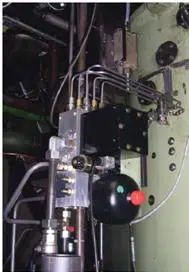Intelligent Cylinder Lubrication for Modern Marine Engines -Part 1
Among the several steps that have been taken lately to convert a conventional marine engine in to a modern, smarter 2-stroke marine engine, the development of intelligent cylinder lubrication plays a vital role.
The main reason for developing hi tech cylinder lubrication system is to reduce the operational costs of the engine. Moreover, the most expensive lubricating oil is generally used for the engine’s combustion chamber as cylinder lube oil. The development of intelligent cylinder lubrication thus makes perfect sense.
In the shipping industry, two giants – MAN Diesel and Wartsila have introduced a remarkable technology for modern electronically controlled marine engines. Known as Alpha and Pulse lubrication systems, this new technology is one-of-its-kind.
In this article we will understand what does pulse lubrication means and how it helps to reduce the cylinder oil feed rate and eventually the operating costs of the ship.
Wartsila- A major player in the marine engine manufacturing industry has introduced an intelligent cylinder lubrication system in its electronically controlled engine. This system is popularly known as the pulse lubrication system.
What is Pulse Lubrication System?
A pulse lubrication system is an electronically controlled cylinder oil lubrication system for Wartsila engines, wherein metered quantity of cylinder oil is injected in to the liner, depending on the engine load. This ensures that accurate amount of cylinder oil is delivered inside the liner at the correct set-time for that particular engine load.
Construction and Working of Pulse Lubrication System
- There are normally eight quills attached to the cylinder liner in a single row, which gets the oil supply from the electronically controlled dosage pump
- The oil is supplied to the dosage pump from daily tank via fine filter of 40 microns
- The quills consist of a duct passage to store metered quantity of oil. The area of this duct passage and the quantity of oil can be altered by changing the position of the central piston
- There are crank angle sensors attached to the engine which give signals to the control unit in order to inject oil at the correct position of piston movement
- 200 bar high pressure servo oil reduced to 50 bars are supplied to the lubricator unit, which pressurises the centre piston in the quills. This injects oil inside the liner at adequate pressure for even distribution
- WECS (Wartsila Engine Control System) which is the master controller of the Pulse lubrication system controls the solenoid valve opening and the oil injection
Each unit is provided with 8 lubricating quills, 2 piping systems of Cylinder oil and servo oil, and A 4/2 solenoid valve to servo oil flow.
After receiving signal from the crank angle sensor, at the correct position i.e. between the pack of piston rings, WECS allows the solenoid valve to open and pass the servo oil. This in turn presses the central piston and delivers the oil stored in the duct passage of the quills.
As soon as the injection is over, there is a small orifice which fills the duct passage again with the cylinder oil as the central piston moves backward. This ensures that the oil is always present in the chamber in metered quantity as decided by the WECS after calculating load and sulphur content of the fuel.
Benefits of Pulse Lubrication System
- Reduction in Cylinder oil Feed rate –up to 0.7 gm/kwh and thus reduction in operating cost
- Well précised delivery of metered cylinder oil giving better lubrication to piston ring and liner
- Better distribution of oil within the liner
- Less fouling of combustion space
- Less fouling of scavenge space
Reference and Image Credit: wartsila
Do you have info to share with us ? Suggest a correction
Subscribe To Our Newsletters
By subscribing, you agree to our Privacy Policy and may receive occasional deal communications; you can unsubscribe anytime.








Sir,thanks for the explanation. I have some doubt regarding the Lubrication(MAN B&W).From cross head the lube oil passes to the piston and the crank pin bearing for cooling. What will be the lube oil pressure in piston, Xhead and crank pin bearing. Will it be same? or if it is different how does that happens? Please clarify my doubt…
The Pressure for lube oil going to piston will be almost same as the system lube oil pressure (slightly less due to pressure drop i.e. if the system pressure is 2.1 bar, the piston lube oil pressure will be approx 1.9 bar)
Thank you Sir….
Please inform which oil is used in the Alpha Lubricator for cylinder liner lubrication.
Thanks for your explanation, but how did the lubricant return back to feed tank or is it consum, and consume, is it not extra cost?.
Really thanks a lot for the helpful information in marine engineering.
For Alpha lubricator they used SAE50 type of oil or cylinder oil having TBN of 70 mg KOH / g.
What are the possible causes of high lube oil consumption in a diesel engine more than 8MW capacity?
Good Day dear !!! Glad to talk with colleagues working on electronic diesel engines ready to discuss any problems for trudlshootings of mentioned ME.
Can you please mention the differences between Pulse and alpha lubrication system
How to set timing of pulse jet lubrication?
@Praveen: “The feed rate is controlled by disc settings in the multi-element pump unit, and by varying the rotational speed of the driving electric motor”.
A very useful article to read. Thanks a lot for sharing this. Fine work. Keep it up.
@Kaizen: Thank you for your support and kind words.
What about the differences between pulse and alpha lubrication system ????
Please kindly advice and reply.
Thanks
@Thaung: the article describes pulse lubrication system from wartsila.
The Alpha Lubrication system is patent of MANdiesel – you can get more info here- https://primeserv.mandieselturbo.com/docs/librariesprovider5/primeserv-documents/alpha-lubricator.pdf?sfvrsn=6